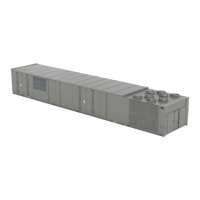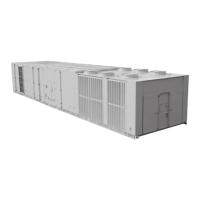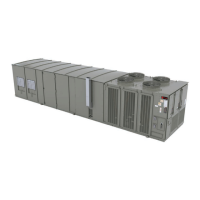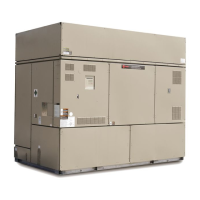RT-SVX073A-EN
81
Low Ambient Operation
Units configured with Low Ambient Operation use a
modulating condenser fan for the first stage.
Hot Gas Bypass
Hot gas bypass is a unit configuration option that, at some
predetermined suction pressure, initiates a modulated flow
of hot refrigerant gas from high side to the low pressure
portion of the refrigeration system. This adds “false load” to
avoid low suction pressures that would otherwise result in
coil frosting. This feature can be disabled, but when
enabled is transparent to the normal staging control
provided by the Symbio 800 controller. Regardless, Hot
Gas Bypass operation indirectly places operating
constraints on the system that have to be addressed by the
unit controls in the areas of EXV superheat control and
dehumidification/reheat operation.
Figure 41. Piping diagram with hot gas bypass
Hot Gas Bypass Control
Activation
If a unit is configured with hot gas bypass, the hot gas
bypass system is functional whenever circuit 1is operating.
The hot gas bypass valve is closed during normal
operation. The valve will open, passing the amount of hot
gas required to produce a suction pressure that is high
enough to prevent coil frosting, when necessary. If Hot Gas
Bypass Enable is Disable, the Hot Gas Bypass valve is
always closed.
Interaction
Hot Gas Reheat and Hot Gas Bypass options are installed
on circuit 1, however, hot gas bypass is not allowed to
operate if the “Hot Gas Reheat Valve Reheat” is open
(>0%). The hot gas bypass valve will open when suction
pressure is lower than the calculated target. In addition, the
valve control has interactions with coil defrost protection,
EXV control and condenser fan control.
HGBP Valve Calibration
HGBP valve calibration (also known as overdrive closed)
procedure is initiated in the following circumstances:
• Whenever the unit controller is power cycled. This is
under the control of the unit controller software, as part
of the software startup procedure. Note: under the most
common scenario when both the HGBP valve
electronic controller and unit controller are power
cycled, HGBP valve recalibration may occur twice.
• When the circuit cycles off and the circuit has run for at
least EXV Recalibration Time since the previous
calibration.
Note: EXV calibration time is used for both HGBP and
EXV valve calibration.
• Whenever the HGBP valve electronic controller is
power cycled. The HGBP valve electronic controller
does this automatically.
EXV Control (Electronic Expansion
Valve)
Electronic expansion valves (EXVs) control suction
superheat to ensure the complete and efficient evaporation
of refrigerant in the evaporator. Excess liquid refrigerant in
the compressor suction (low suction superheat) can be
harmful to the compressor, and a deficit of liquid in the
evaporator (high suction superheat) is inefficient. The
benefit of EXV control, through controlling suction
superheat, suction pressure, suction saturated
temperature, or pressure ratio, promotes energy-efficient
operation and long-term reliability of the compressor(s).
Suction superheat is the difference between suction
temperature and saturated suction temperature. A
temperature sensor measures suction temperature. The
saturated suction temperature is determined from the
measured suction pressure by a refrigerant property
calculation. Typically, the EXV control maintains a small,
desired amount of suction superheat by opening or closing
the EXV(s), which adjusts the refrigerant flow rate into the
evaporator.
In certain situations, such as cold ambient starts, warm
supply air starts, the EXV control can automatically move
into a suction pressure control mode, allowing the suction
superheat to deviate from the superheat setpoint. The goal
of the suction pressure control mode is to maintain suction
pressure or differential pressure within the compressor
operating map.
In situations where the superheat rapidly falls to very low
values, special control modes are necessary to dry out
excess refrigerant liquid in the evaporator, suction line, and
compressor sumps, and transition back to normal control.
Configuration
Electronic Expansion Valves are always installed on DX
refrigeration circuits. Configuration is used to specify the
EXV selection on each refrigeration circuit. EXV selection
allows picking of a correlation between EXV steps or EXV
percent open, and the flow coefficient (C
v
) at each EXV
opening.
Unit Startup

